2010年武汉外校英语真题详析
2010年武汉大学二外英语考研真题试卷.doc
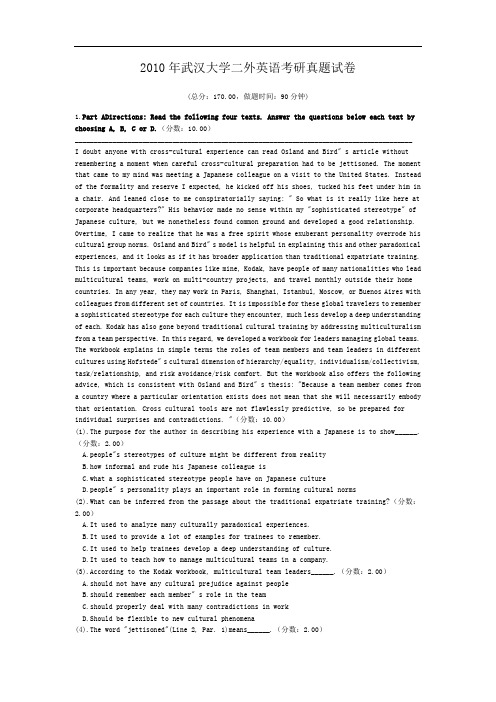
2010年武汉大学二外英语考研真题试卷(总分:170.00,做题时间:90分钟)1.Part ADirections: Read the following four texts. Answer the questions below each text by choosing A, B, C or D.(分数:10.00)__________________________________________________________________________________________I doubt anyone with cross-cultural experience can read Osland and Bird" s article without remembering a moment when careful cross-cultural preparation had to be jettisoned. The moment that came to my mind was meeting a Japanese colleague on a visit to the United States. Instead of the formality and reserve I expected, he kicked off his shoes, tucked his feet under him in a chair. And leaned close to me conspiratorially saying: " So what is it really like here at corporate headquarters?" His behavior made no sense within my "sophisticated stereotype" of Japanese culture, but we nonetheless found common ground and developed a good relationship. Overtime, I came to realize that he was a free spirit whose exuberant personality overrode his cultural group norms. Osland and Bird" s model is helpful in explaining this and other paradoxical experiences, and it looks as if it has broader application than traditional expatriate training. This is important because companies like mine, Kodak, have people of many nationalities who lead multicultural teams, work on multi-country projects, and travel monthly outside their home countries. In any year, they may work in Paris, Shanghai, Istanbul, Moscow, or Buenos Aires with colleagues from different set of countries. It is impossible for these global travelers to remember a sophisticated stereotype for each culture they encounter, much less develop a deep understanding of each. Kodak has also gone beyond traditional cultural training by addressing multiculturalism from a team perspective. In this regard, we developed a workbook for leaders managing global teams. The workbook explains in simple terms the roles of team members and team leaders in different cultures using Hofstede" s cultural dimension of hierarchy/equality, individualism/collectivism, task/relationship, and risk avoidance/risk comfort. But the workbook also offers the following advice, which is consistent with Osland and Bird" s thesis: "Because a team member comes from a country where a particular orientation exists does not mean that she will necessarily embody that orientation. Cross cultural tools are not flawlessly predictive, so be prepared for individual surprises and contradictions. "(分数:10.00)(1).The purpose for the author in describing his experience with a Japanese is to show______.(分数:2.00)A.people"s stereotypes of culture might be different from realityB.how informal and rude his Japanese colleague isC.what a sophisticated stereotype people have on Japanese cultureD.people" s personality plays an important role in forming cultural norms(2).What can be inferred from the passage about the traditional expatriate training?(分数:2.00)A.It used to analyze many culturally paradoxical experiences.B.It used to provide a lot of examples for trainees to remember.C.It used to help trainees develop a deep understanding of culture.D.It used to teach how to manage multicultural teams in a company.(3).According to the Kodak workbook, multicultural team leaders______.(分数:2.00)A.should not have any cultural prejudice against peopleB.should remember each member" s role in the teamC.should properly deal with many contradictions in workD.Should be flexible to new cultural phenomena(4).The word "jettisoned"(Line 2, Par. 1)means______.(分数:2.00)A.counted onB.neglectedC.modifiedD.given up(5).What is the author"s attitude towards Osland and Bird"s article?(分数:2.00)A.Critical.B.Positive.C.Neutral.D.Dubious.As everyone knows, there are far too many people in the word. Or at least, there soon will be too many people, because the rate of population increase is running out of control. We are, as they say, breeding like rabbits, and rabbits are widely recognized as destructive animals. People are possibly the most serious of all pollutants. We hear this so often, from such distinguished persons, that it must be true. So we accept it. The arithmetic tells its own story and never better than in the words of Paul Ehrlich, whose Population Bomb drew the matter to our attention many years ago. " Let" s examine what might happen on the absurd assumption that the population continued to double every 37 years into the indefinite future. If growth continued at that rate for about 900 years, there would be some 60,000,000, 000,000,000 people on the face of the earth. Sixty million billion people. This is about 100 persons for each square yard of the Earth" s surface, land and sea. " Images were generated in which the entire visible universe consisted of a solid mass of human bodies. It is not really the fault of us western Europeans, Australians and North Americans. It is not in our countries that the increase is taking place. Growth is concentrated in the less industrialized countries, among the poor. The people of Whom we have, or will have, too many are poor, many of them are very poor indeed, and there seems to be little that can be done about it, beyond urging them to behave more responsibly and criticizing those who oppose the widespread provision of contraceptive devices. The choice we face in our arithmetic of poor people is between reducing one or other of the two apparent variables: the people or their poverty. In fact it is not that simple, for reducing poverty would surely encourage people to breed faster, so eliminating what we had helped them to gain at no small cost to ourselves. No matter how you look at it, the future seems pretty grim. Obviously, such a rate of growth cannot be sustained. The question centers not on whether it will end, but how, and most commentators, following the line of reasoning popularized by Paul Ehrlich, suppose the end will be disastrous. Our numbers will be reduced; sword, fire, famine and pestilence will sweep the world on an unprecedented scale.(分数:10.00)(1).According to the passage, the word" s overpopulation is due to______.(分数:2.00)A.uncontrolled birth rateB.reproduction of destructive animalsC.recognition of people as serious pollutantsD.constant repetition of it by distinguished persons(2).Paul Ehrlich, who was the first to use " population bomb" ______.(分数:2.00)A.did not believe in the story told by the arithmeticB.believed that population bomb would never explodeC.did not believe population growth rate would sustainD.generated a gloomy prediction about world population growth(3).The passage indicates that______.(分数:2.00)A.there are fears of less industrialized countriesB.there are fears of the rapid growth of world populationC.people"s a fears of " population bomb" are ungroundedD.people" s fears of "population bomb" are disastrous(4).The author of the passage seems very depressed and pessimistic about the future because (分数:2.00)A.many people are against providing contraceptive devicesB.growth takes place among the very poor in the less industrialized countriesC.many people refuse to take advice and behave responsiblyD.reducing numbers and lessening poverty are heavily dependent on each other(5).The line of reasoning popularized by Paul Ehrlich suggests______.(分数:2.00)A.that the rate or growth could not be checked without war or natural disastersB.either family size or poverty should be reducedC.serious warnings should be given against disastersD.that danger we face is more serious than we imagineShakespeare, apparently, had it right. All the world is a stage. " You are actors, and the stage is your family," says Claude Gudner, a marriage and family therapist in Ontario, Canada. "The kids see everything on that stage. " For better or worse, our day-to-day interactions with our spouse—such things as decision making , conflict and displays of affection-slowly construct what Judith Siegel calls our children" s " blueprint for intimacy. " Siegel is the author of What Children Learn from Their Parents" Marriage. She says research shows that this primary model of intimacy makes a lasting impression on kids. " In a problematic marriage, children might develop behavior problems or health problems such as gaining weight or headaches," says Siegel. Their grades may drop, their personalities change. And kids can carry the burden of marital difficulties into their own adult relationships. " Not only can kids take on their parents" unfinished business, but this can be passed down generation upon generation," Gudner explains. There" s a positive flip side to this, of course. " When we look at children who come from families where there are healthy marital relationships, we see it reflected in their physical health as well as their ability to function well socially and academically," says Siegel. Experts and parents agree that the bedrock of a healthy marriage is mutual respect " It" s always been very important to us that we don" t cut each other down in front of the kids," says Jasmine Burns. Saving criticism until after the fact can also work. " Many times I think my husband is too hard on the boys," says Iwona McNeil. " But I let him handle the situation, and then when we are alone, I let him know what I think. " Siegel also urges parents to be careful when and where they choose to blow off steam about their spouse" s shortcomings. " People sometimes complain to their family and friends about their partner on the telephone, not realizing that their children are listening," she explains.(分数:10.00)(1).The best title for the passage might be______.(分数:2.00)A.Our Life Is A StageB.Children Watch UsC.Saving CriticismD.Children" s Blueprint(2).A better interaction between the parents is very important to children in that______.(分数:2.00)A.it shows mutual respectB.it lets children enjoy more loveC.it enhances children" s developmentD.it makes a last impression on children(3).Siegel believes that the cause for children" s loneliness might be______.(分数:2.00)A.parents" higher expectationB.their own personality changeC.their failure in academic studyD.parents" marital difficulties(4).McNeil seldom criticizes her husband openly in that______.(分数:2.00)A.her husband can correct his own mistakesB.she fears her children will see her criticismC.she loves her husband is very considerateD.her husband values much his own dignity(5).What can be learned from the last paragraph?(分数:2.00)A.Don" t complain about your partners in front of children.B.Don" t complain about anyone on the telephone.C.Be careful when talking about others" shortcomings.D.Be considerate to your family and friends.One of the biggest barriers to effective negotiation and a major cause of stalemate is the tendency for bargainers to get trapped in their own perspectives. It" s simply too easy for people to become overly confident of their opinions. Operating in a closed world of their making, they tell themselves they are right and the others are wrong. They consider the merits of their positions but neglect the other party" s valid objections. They push their agendas, merely with the same argument, and may not pick up on cues that their words aren" t being heard. It" s safe to assume that the other party is just as convinced that his or her own demands are justified. Moreover, bargainers can only speculate what another" s agenda might be—hidden or otherwise. Appreciative moves to draw out another" s perspective help negotiators understand why the other party feels a certain way. They signal to the other side that different opinions and perspectives are important. By creating opportunities to discover something new and unexpected, appreciative moves can break a stalemate. Everyone agreed that a joint venture negotiated by HMO executive Donna Hitchcock between her organization and an insurance company has mutual benefits on both sides. Although the deal looked good on paper, implementation stalled. Hitchcock couldn" t understand where the resistance was coming and why. In attempt to unfreeze the situation, she arranged a meeting with her counterpart from the insurance company. After a brief update, Hitchcock asked a-bout any unexpected effects the joint venture was exerting on the insurance organization and on Her counterpart" s work life. That appreciative move immediately broke the logjam. From her counterpart " s perspectives, she learned, the new arrangement stretched already overworked departments and had not yet produced additional revenues to hire more staff. Even more important, her counterpart was personally bearing the burden of the increased work. Hitchcock was genuinely sympathetic to these concerns. The extra work was legitimate obstacle to implementation. Once she understood the reason behind the resistance, the two were able to strategize on ways to alleviate the overload until the additional revenues kicked in.(分数:10.00)(1).The best title for the passage might be______.(分数:2.00)A.Solicit New PerspectivesB.Respect Your CounterpartC.Avoid Obstacles to NegotiationD.Listen to Others" Objection(2).Many people are likely to push their agenda just because______.(分数:2.00)A.there are not any valid objectionsB.there are no barriers to negotiationC.they are too confident in their abilityD.they believe they are justified(3).The purpose for the author in citing Hitchcock" s example is______.(分数:2.00)A.to explain why many people often fail in the negotiationB.to suggest how we can become more appreciativeC.to suggest how we can value other people" s valuesD.to explain why many people often expect something new(4).The word "logjam"(Line 5 , Para. 4)means______.(分数:2.00)A.blockB.failureC.prejudiceD.misunderstanding(5).Hitchcock couldn" t succeed in implementing the plan at beginning in that______.(分数:2.00)A.she didn" t know what difficulties her counterpart hadB.she didn" t show the potential advantages to her counterpartC.she didn" t expect what would happen in the cooperationD.she didn" t find proper strategies and methods2.She wrote an______letter to the newspaper complaining about the council" s action.(分数:2.00)A.disappointedB.surprisedC.indignantD.disapproved3.There" s growing______among the electorate with the old two-party system.(分数:2.00)A.impatienceB.disbeliefC.hopelessnessD.insistence4.He could have told us what had happened, but he did not______to.(分数:2.00)A.chooseB.promiseC.selectD.allow5.It is impossible to______the news unless you read the newspaper every day.(分数:2.00)A.look up inB.keep up withC.put up withD.follow up6.The missing child" s parents became more and more worried as the hours______.(分数:2.00)A.spentB.missedC.passedD.went7.As the bus______into the station there was a rush to get seats.(分数:2.00)A.drewB.sentC.arrivedD.pulled8.Unable to speak a word of that language, he______with his hands.(分数:2.00)A.relatedmunicatedC.connectedD.exchanged9.We"ll need______milk if Bob and Mary are coming for the weekend.(分数:2.00)A.otherB.extraC.spareD.further10.The growing______of the company is reflected in the high price of its shares.(分数:2.00)A.developmentB.probabilityC.potentialD.possibility11.For wildlife enthusiasts the journey is______because the region is known for its sea birds.(分数:2.00)A.funnyB.worthyC.pleasedD.worthwhile12.The rent is reasonable and______, the location is perfect.(分数:2.00)A.moreoverB.thoughC.thereforeD.however13.Grandma was insistent that we______her soon.(分数:2.00)A.went and visitedB.go and visitC.went for visitingD.go for visiting14.I______you the money. Why didn" I you ask me?(分数:2.00)A.would lendB.could have lentC.must have lentD.had lent15.This car has been______trouble: it" s always breaking down.(分数:2.00)A.anything butB.nothing butC.all butD.none but16.______by the news of his father" s death, he could hardly utter a word.(分数:2.00)A.To be stunnedB.Being stunnedC.StunnedD.Stunning17.You can go out, ______you promise to be back before 11 o" clock.(分数:2.00)A.even thoughB.ever sinceC.as far asD.as long as18.We dare not play jokes on her______she should become angry.(分数:2.00)A.lestB.unlessC.for fear ofD.so that19.She was, ______her fame and fortune, basically an unhappy woman.(分数:2.00)A.despite fromB.howeverC.in spite ofD.even though20.He kept the portrait ______he could see it every day, as it always reminded him of his early school days.(分数:2.00)A.whereB.whenC.whichD.for21.The harder a student studies, ______.(分数:2.00)A.the more his body gives off heatB.his body gives off more heatC.the more heat does his body gives offD.the more heat his body gives off22.It must be______that he disliked her from the first.(分数:2.00)A.recognizedB.acknowledgedC.saidD.thought23.In recent years there has been a strong______toward the "open classroom" in the elementary schools of the United States.(分数:2.00)A.assumptionB.transitionC.bentD.tendency24.As a result of the radio______for help for the earthquake victims, over a million pounds have been raised.(分数:2.00)A.appealB.transmissionC.programD.advertisement25.______he prepared his lessons well; at other times he does very poor work.(分数:2.00)A.Now and thenB.First and lastC.On one occasionD.At first26.The roads were very busy so traffic______along at 10 miles an hour.(分数:2.00)A.climbedB.dashedC.crawledD.drifted27.In a hospital for the mentally ill, much of the nurse" s time is devoted to maintaining a safe environment for the patients and also helping them to understand and______essential safety measures.(分数:2.00)A.take credit forB.put into practiceC.hand downD.blend in28.He was a handsome young man, usually______, in pleasant contrast to Tottenhoe" s glumness.(分数:2.00)A.lightheadedB.upsetC.cheerfulD.thoughtful29.Under the______of the University, doctor" s thesis must be printed.(分数:2.00)A.demandsB.termsC.disciplinesD.regulations30.Since there was no place to take shelter, we got______in the sudden downpour.(分数:2.00)A.sprayedB.soakedC.stainedD.sticky31.We are about to ______a revolution in transport both above and below the surface of the sea.(分数:2.00)A.giveB.handleC.establishD.witnessAn unending flow of private and public criticism suggests that the people of the United States suffer【C1】______government, national, state and local, 【C2】______is corrupt and inefficient. The criticism reflects the【C3】______standards which the Americans have【C4】______as their ideals. The political system has provided the【C5】______for a society adapting itself【C6】______continuing rapid change【C7】______a scale never seen anywhere before, to immigration, to the development of the west, to the【C8】______of new technology, and to spontaneous economic【C9】______At the same time it has, 【C10】______the whole, avoided oppression and provided the means of expressing 【C11】______well the wishes of this huge and【C12】______population, so that violent discontents have been【C13】______Finally, it has provided the 【C14】______for the United States to be a world【C15】______on a scale that has not been【C16】______before, using its power for influence , 【C17】______conquest【C18】______have been mistakes and tragedies, but【C19】______by the standard of human society as a whole they have been【C20】______, and overshadowed by successes.(分数:40.00)(1).【C1】(分数:2.00)A.atB.inC.withD.from(2).【C2】(分数:2.00)A.thatB.whichC.itD.as(3).【C3】(分数:2.00)A.rightB.lowC.highD.strange(4).【C4】(分数:2.00)A.setB.putC.madeD.got(5).【C5】(分数:2.00)A.rulesB.rulersC.exceptionsD.except(6).【C6】(分数:2.00)A.forB.withC.atD.to(7).【C7】(分数:2.00)A.atB.onC.forD.with(8).【C8】(分数:2.00)A.attendanceB.accessC.absorptionD.attraction(9).【C9】(分数:2.00)A.declineB.failureC.increasingD.growth(10).【C10】(分数:2.00)A.onB.forC.atD.with(11).【C11】(分数:2.00)A.fairB.quietC.reasonablyD.occasionally(12).【C12】(分数:2.00)A.variousB.variedC.varyingD.variety of(13).【C13】(分数:2.00)A.regularB.irregularC.exceptionalD.excepted(14).【C14】(分数:2.00)A.endsB.meansC.victoryD.success(15).【C15】(分数:2.00)A.powerB.countryC.nationD.machine(16).【C16】(分数:2.00)A.metB.encounteredC.heardD.known(17).【C17】(分数:2.00)A.ratherB.insteadC.notD.for(18).【C18】(分数:2.00)A.TheyB.ThereC.ThatD.Powers(19).【C19】(分数:2.00)A.judgedB.judgingC.thoughtD.thinking(20).【C20】(分数:2.00)A.plentifulB.adequateC.littleD.rare32.Part CDirections: Read the following text carefully and then translate the underlined segments into Chinese.(分数:2.00)__________________________________________________________________________________________ 33.对不起,我迟到了。
2010年武汉市中考英语试卷详解(完整版)
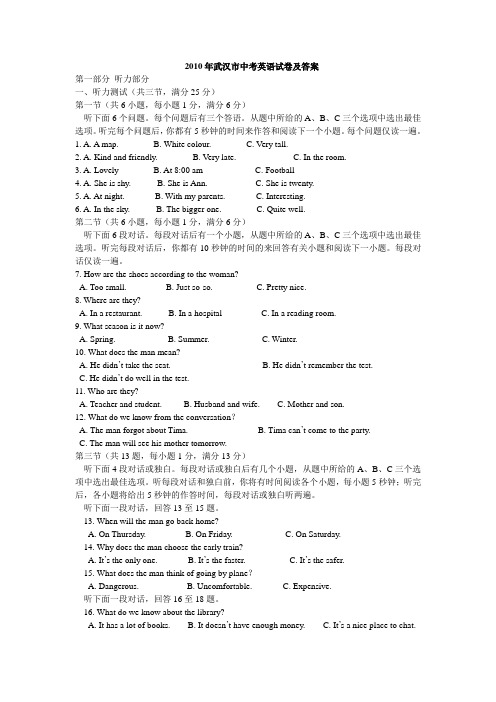
2010年武汉市中考英语试卷及答案第一部分听力部分一、听力测试(共三节,满分25分)第一节(共6小题,每小题1分,满分6分)听下面6个问题。
每个问题后有三个答语。
从题中所给的A、B、C三个选项中选出最佳选项。
听完每个问题后,你都有5秒钟的时间来作答和阅读下一个小题。
每个问题仅读一遍。
1. A. A map. B. White colour. C. Very tall.2. A. Kind and friendly. B. Very late. C. In the room.3. A. Lovely B. At 8:00 am C. Football4. A. She is shy. B. She is Ann. C. She is twenty.5. A. At night. B. With my parents. C. Interesting.6. A. In the sky. B. The bigger one. C. Quite well.第二节(共6小题,每小题1分,满分6分)听下面6段对话。
每段对话后有一个小题,从题中所给的A、B、C三个选项中选出最佳选项。
听完每段对话后,你都有10秒钟的时间的来回答有关小题和阅读下一小题。
每段对话仅读一遍。
7. How are the shoes according to the woman?A. Too small.B. Just so-so.C. Pretty nice.8. Where are they?A. In a restaurant.B. In a hospitalC. In a reading room.9. What season is it now?A. Spring.B. Summer.C. Winter.10. What does the man mean?A. He didn‘t take the seat.B. He didn‘t remember the test.C. He didn‘t do well in the test.11. Who are they?A. Teacher and student.B. Husband and wife.C. Mother and son.12. What do we know from the conversation?A. The man forgot about Tima.B. Tima can‘t come to the party.C. The man will see his mother tomorrow.第三节(共13题,每小题1分,满分13分)听下面4段对话或独白。
2010年武汉中考英语解析

2010年武汉市中考英语试卷及答案第一部分听力部分一、听力测试(共三节,满分25分)第一节(共6小题,每小题1分,满分6分)听下面6个问题。
每个问题后有三个答语。
从题中所给的A、B、C三个选项中选出最佳选项。
听完每个问题后,你都有5秒钟的时间来作答和阅读下一个小题。
每个问题仅读一遍。
1. A. A map. B. White colour. C. Very tall.2. A. Kind and friendly. B. Very late. C. In the room.3. A. Lovely B. At 8:00 am C. Football4. A. She is shy. B. She is Ann. C. She is twenty.5. A. At night. B. With my parents. C. Interesting.6. A. In the sky. B. The bigger one. C. Quite well.第二节(共6小题,每小题1分,满分6分)听下面6段对话。
每段对话后有一个小题,从题中所给的A、B、C三个选项中选出最佳选项。
听完每段对话后,你都有10秒钟的时间的来回答有关小题和阅读下一小题。
每段对话仅读一遍。
7. How are the shoes according to the woman?A. Too small.B. Just so-so.C. Pretty nice.8. Where are they?A. In a restaurant.B. In a hospitalC. In a reading room.9. What season is it now?A. Spring.B. Summer.C. Winter.10. What does the man mean?A. He didn‘t take the seat.B. He didn‘t remember the test.C. He didn‘t do well in the test.11. Who are they?A. Teacher and student.B. Husband and wife.C. Mother and son.12. What do we know from the conversation?A. The man forgot about Tima.B. Tima can‘t come to the party.C. The man will see his mother tomorrow.第三节(共13题,每小题1分,满分13分)听下面4段对话或独白。
2010年武汉外校英语真题详析

2010年武汉外校英语真题详析D2010外校英语试题考点解析1. 听力部分从分值看,听力由去年的30分上涨至35分,题量由六大题升至七大题,题型基本保持稳定,但在细节上做了微调。
表现在:一. 听力第一小题由听歌选择变为听歌填空,要求学生听一首英语儿歌并填词,这题不光考学生的耳朵,也考查联系上下文进行推断的能力。
二. 六七大题依然是听力部分的难点题,也是拉分题。
主要以图句配对,判断选择为主,但在听力材料的内容理解上难度增加,2010年本题是关于美国地域文化和墨西哥概况。
考生对材料相对陌生,所以得分相当不理想。
该材料来源于九年级课外阅读。
2. 阅读部分2010的阅读部分让人始料未及,分值从25分直降至10分,题型也由传统的阅读理解题转变的更加灵活,选材也更贴近日常生活。
试卷上的第一个阅读是句子排序,题目给出了首尾的两句,降低了难度。
这种题要求考生能读懂每个句子,捕捉句中有效信息并能串联信息。
第二个阅读根据描述选择对应的网站,较容易得分,每句都很长并有很多超纲词汇,但并不影响考生理解大致意思,此题考查学生从大量信息中筛选有效信息的能力,排除干扰项快速判断等能力。
另一个必须强调的是,虽然2010的阅读只有10分,但这绝不表明外校考试对阅读能力的要求降低。
恰恰相反,要求更高,从后面的思维扩展题看出,考生必须要能读懂句子才能理解题意,否则就算你数学再好,也只能是巧妇难为无米之炊。
3. 思维发展部分2010年的思维发展题占20分,题量加大,题型多样化的特点越来越明显,包括数字图形推断题,知识面,行为规范等方面。
这部分的题是让家长和考生最头疼的,因为太灵活,不好针对性复习。
但从试题中我们可以分析出外校对学生综合能力的要求异常高,要求学生至少具备中考英语词汇量、阅读理解水平,逻辑推理判断能力和知识迁移能力。
听力第一题(答案及解析)I’m a policeman dressed in blue, here are some thing s I like to do. Direct the traffic in your town, help to keep you safe and sound. It’s my job and I like it fine. No one has a better job than mine.I’m a policeman dressed in blue, I want to be a friend to you.you can see me every day,I will wave my hand to see.it my job and I like it fine. No one has a better job than mine.解析:本题考点有词语拼写正确,名词的单复数和将来时态;解题技巧:在预习时对填词处进行初步判断,切忌边听边填。
武汉外校入学考试真题英语
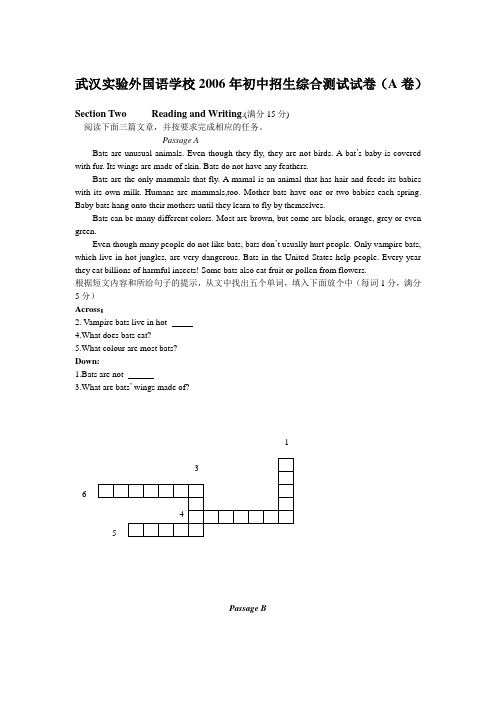
武汉实验外国语学校2006年初中招生综合测试试卷(A卷)Section Two Reading and Writing.(满分15分)阅读下面三篇文章,并按要求完成相应的任务。
Passage ABats are unusual animals. Even though they fly, they are not birds. A bat’s baby is covered with fur. Its wings are made of skin. Bats do not have any feathers.Bats are the only mammals that fly. A mamal is an animal that has hair and feeds its babies with its own milk. Humans are mammals,too. Mother bats have one or two babies each spring. Baby bats hang onto their mothers until they learn to fly by themselves.Bats can be many different colors. Most are brown, but some are black, orange, grey or even green.Even though many people do not like bats, bats don’t usually hurt people. Only vampire bats, which live in hot jungles, are very dangerous. Bats in the United States help people. Every year they eat billions of harmful insects! Some bats also eat fruit or pollen from flowers.根据短文内容和所给句子的提示,从文中找出五个单词,填入下面放个中(每词1分,满分5分)Across:2. V ampire bats live in hot4.What does bats eat?5.What colour are most bats?Down:1.Bats are not3.What are bats’ wings made of?Passage B阅读药品标签上的使用说明,回答下面各题:(每小题一分,满分5分)1.Can a child with temperature take this medicine?2.How much medicine should a 5-year-old take at a time?3.How often can this medicine be taken?4.Who knows how much medicine to give a 1-year-old?5.Who should not take this medicine? Children withPassage CDear Sir/ Madam,When I was seated on the top deck of a bus recently, I was shocked by the behaviour of some students from Westlake College. They were eating hamburgers and drinking cola. When they reached their stop, they got off, leaving the empty cartons and cups on the bus. I was forced to speak to one of them about this as he went past me, but he just laughed. “It’s not my job to clean the bus,” he said. “Why should I do it?”Is this the attitude of young people today? Don’t they care about their environment? Are they content to let other people clean up after them all the time?Shanghai would look disgusting ifeverybody behaved as these students did. Moreover, as a 66-year-old grandfather, I was not happyabout being laughed at by a schoolchild. The youth of today have no respect to their elders.Y ours faithfully,Charles Wang根据文章内容,选择下列五个问题的正确答案,并将代表该答案的字母填在题目前的括号内。
2010英语一真题(后附答案详解)
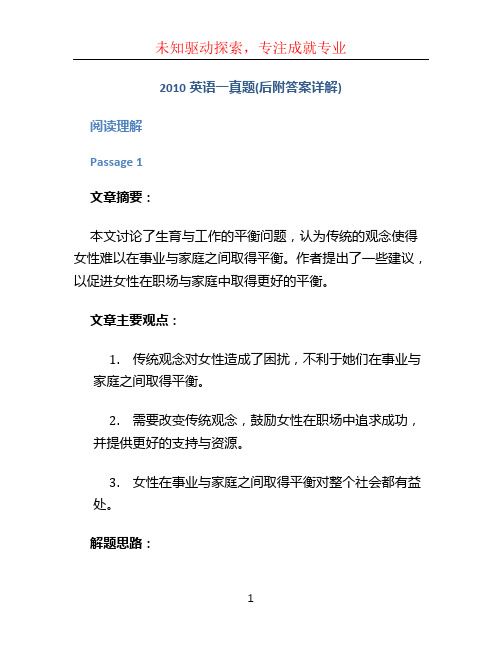
2010英语一真题(后附答案详解)阅读理解Passage 1文章摘要:本文讨论了生育与工作的平衡问题,认为传统的观念使得女性难以在事业与家庭之间取得平衡。
作者提出了一些建议,以促进女性在职场与家庭中取得更好的平衡。
文章主要观点:1.传统观念对女性造成了困扰,不利于她们在事业与家庭之间取得平衡。
2.需要改变传统观念,鼓励女性在职场中追求成功,并提供更好的支持与资源。
3.女性在事业与家庭之间取得平衡对整个社会都有益处。
解题思路:本文主要讲述了生育与工作的平衡问题,作者观点明确,文章结构清晰,很容易找到答案。
答案详解:1.According to the author, a successful career womanis usually one who ______.因为前半部分提到了“What does it take for a woman to become successful in business? Talent, stamina, and theability to work long hours…” 后半部分又提到了“My ownresearch, on the other hand, suggests that becoming asuccessful business woman usually requires a largemeasure of luck.” 可知,作者认为一个成功的职业女性通常需要的是运气而不是实力。
答案:D. has more than a fair share of luck.2.It can be inferred from the passage that ______.根据文章最后一句可以判断出以上观点都是错误的。
答案:A. none of the traditional views on balancing work and family is correct.3.What is preventing women from striking a balancebetween family and work, according to some researchers?根据文章最后一段的描述可以得知,很多研究者认为传统的观念对女性造成了困扰,防碍了她们在事业和家庭之间取得平衡。
2010年湖北卷英语高考试卷(原卷 答案)

绝密★启用前2010年普通高等学校招生全国统一考试(湖北卷)英语本试卷共80题,共150分。
考试结束后,将本试卷和答题卡一并交回。
注意事项:1.答题前,考生先将自己的姓名、准考证号码填写清楚,将条形码准确粘贴在条形码区域内。
2.答题时请按要求用笔。
3.请按照题号顺序在答题卡各题目的答题区域内作答,超出答题区域书写的答案无效;在草稿纸、试卷上答题无效。
4.作图可先使用铅笔画出,确定后必须用黑色字迹的签字笔描黑。
5.保持卡面清洁,不要折叠、不要弄破、弄皱,不准使用涂改液、修正带、刮纸刀。
第一部分听力(共两节,满分30分)第一节(共5小题:每小题1.5分,满分7.5分)听下面5段对话,每段对话后有一个小题,从题中所给的A、B、C三个选项选出最佳选项,并标在试卷的相应位置,听完每段对话后,你都有10秒钟的时间来回答有关小题和阅读下小题,每段对话仅读一遍。
1.What will the man probably do?A.Take a rest.B.Go to a party.C.Meet his boss.2.What do we know about the man?A.He has been caught copying a report.B.He is not free at the moment.C.He won't leave till the last minute.3.What is the woman concerned about?A.Her health.B.Her character.C.Her appearance.4.What does the man mean?A.The fridge will be fixed.B.The room will be warmer.C.The lights will be switched on.5.What does the man imply?A.The woman already has too many shoes.B.The new shoes do not look good enough.C.He doesn't care where to put the new shoes.第二节(共15小题:每小题1.5分,满分22.5分)听下面5段对话。
2010年高考湖北英语卷详细解析

绝密☆启用前试卷类型:B 2010年普通高等学校招生全国统一考试(湖北卷)英语本试题卷共16页。
全卷满分150分。
考试用时120分钟。
★祝考试顺利★第一部分:听力(共两节,满分30分)做题时,先将答案划在试卷上。
录音内容结束后,你将有两分钟的时间将试卷上的答案转涂到答题卡上。
录音下载地址/f/8136804.html)第一节(共5小题;每小题1. 5分,满分7. 5分)听下面5段对话。
每段对话后有一个小题,从题中所给的A、B、C三个选项中选出最佳选项,并标在试卷的相应位置。
听完每段对话后,你都有10秒钟的时间来回答有关小题和阅读下一小题。
每段对话仅读一遍。
1. What will the man probably do?A. Take a rest.B. Go to a party.C. Meet his boss.2. What do we know about the man?A. He has been caught copying a report.B. He is not free at the moment.C. He won’t leave till the last minute.3. What is the woman concerned about?A. Her health.B. Her character.C. Her appearance.4. What does the man mean?A. The fridge will be fixed.B. The room will be warmer.C. The lights will be switched on.5. What does the man imply?A. The woman already has too many shoes.B. The new shoes do not look good enough.C. He doesn’t care where to put the new shoes.第二节(共15小题;每小题1. 5分,满分22. 5分)听下面5段对话或独白。
2010年湖北武汉中考英语试题及答案(word版)
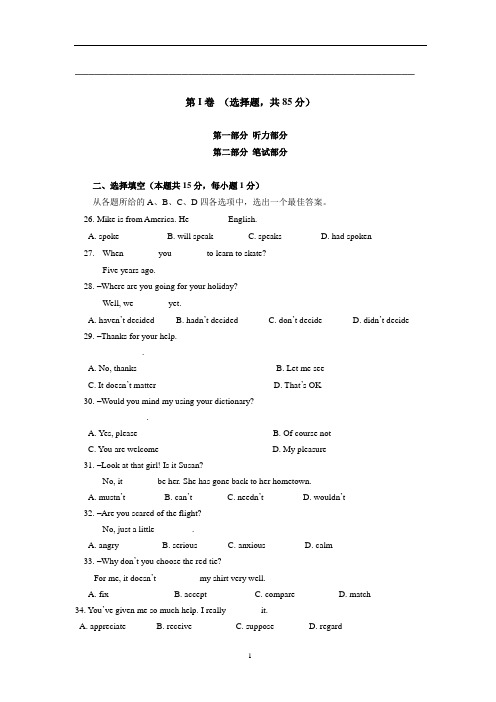
___________________________________________________第I卷(选择题,共85分)第一部分听力部分第二部分笔试部分二、选择填空(本题共15分,每小题1分)从各题所给的A、B、C、D四各选项中,选出一个最佳答案。
26. Mike is from America. He ________ English.A. spokeB. will speakC. speaksD. had spoken27. --When _______ you _______ to learn to skate?--Five years ago.28. –Where are you going for your holiday?--Well, we _______ yet.A. haven‟t decidedB. hadn‟t decidedC. don‟t decideD. didn‟t decide29. –Thanks for your help.--_________.A. No, thanksB. Let me seeC. It doesn‟t matterD. That‟s OK30. –Would you mind my using your dictionary?--__________.A. Yes, pleaseB. Of course notC. You are welcomeD. My pleasure31. –Look at that girl! Is it Susan?--No, it _______ be her. She has gone back to her hometown.A. mustn‟tB. can‟tC. needn‟tD. wouldn‟t32. –Are you scared of the flight?--No, just a little ________.A. angryB. seriousC. anxiousD. calm33. –Why don‟t you choose the red tie?--For me, it doesn‟t _________ my shirt very well.A. fixB. acceptC. compareD. match34. You‟ve given me so much help. I really _______ it.A. appreciateB. receiveC. supposeD. regard35. –Why are you still waiting in line?--I‟ve missed my _______ .A. placeB. orderC. turnD. time36. –How many students are there in the classroom?--__________. They are all in the lab.A. SomeB. NoneC. AllD. Neither37. –Waiter, $ 20 for dinner, right?--I‟m afraid $25, sir, for drinks are ________.A. extraB. freeC. highD. spare38. –Do you know the man under the tree?--Sorry, I don‟t know _______.A. how is heB. what is heC. who he isD. bother39. –How about the exhibition that day?--It was very noisy, but that didn‟t ________ me.A. hurtB. impressC. changeD. bother40. It was a difficult time, but we never ________ hope.A. put upB. gave upC. picked upD. used up三、完形填空(本题共15分,每小题1分)阅读下面短文,掌握其大意,然后从41---55各题所给的A、B、C、D四各选项中,选出一个最佳答案。
高考英语湖北卷真题及答案详解(00001)

2010年普通高等学校招生全国统一考试(湖北卷)英语第一部分:听力(共两节,满分30分)第一节(共5小题;每小题1. 5分,满分7. 5分)1. What will the man probably do?A. Take a rest.B. Go to a party.C. Meet his boss.2. What do we know about the man?A. He has been caught copying a report.B. He is not free at the moment.C. He won’t leave till the last minute.3. What is the woman concerned about?A. Her health.B. Her character.C. Her appearance.4. What does the man mean?A. The fridge will be fixed.B. The room will be warmer.C. The lights will be switched on.5. What does the man imply?A. The woman already has too many shoes.B. The new shoes do not look good enough.C. He doesn’t care where to put the new shoes.第二节(共15小题;每小题1. 5分,满分22. 5分)听第6段材料,回答第6、7题。
6. Why doesn’t the man want to fly?A. He wants to enjoy the scenery.B. He thinks it’s dangerous.C. He likes taking the bus.7. Which means of transport does the woman prefer?A. The bus.B. The train.C. The car.听第7段材料,回答第8、9题。
2010年高考英语湖北卷真题及答案详解【精选文档】

2010年普通高等学校招生全国统一考试(湖北卷)英语第一部分:听力(共两节,满分30分)第一节(共5小题;每小题1. 5分,满分7. 5分)1。
What will the man probably do?A。
Take a rest.B. Go to a party。
C. Meet his boss。
2. What do we know about the man?A. He has been caught copying a report。
B. He is not free at the moment。
C. He won't leave till the last minute.3。
What is the woman concerned about?A. Her health.B. Her character.C. Her appearance。
4。
What does the man mean?A. The fridge will be fixed。
B. The room will be warmer.C。
The lights will be switched on。
5。
What does the man imply?A。
The woman already has too many shoes.B. The new shoes do not look good enough.C. He doesn't care where to put the new shoes。
第二节(共15小题;每小题1。
5分,满分22。
5分)听第6段材料,回答第6、7题。
6. Why doesn’t the man want to fly?A. He wants to enjoy the scenery。
B。
He thinks it’s dangerous.C。
He likes taking the bus。
湖北省武汉外国语学校10-11学年高一上学期期末考试英语
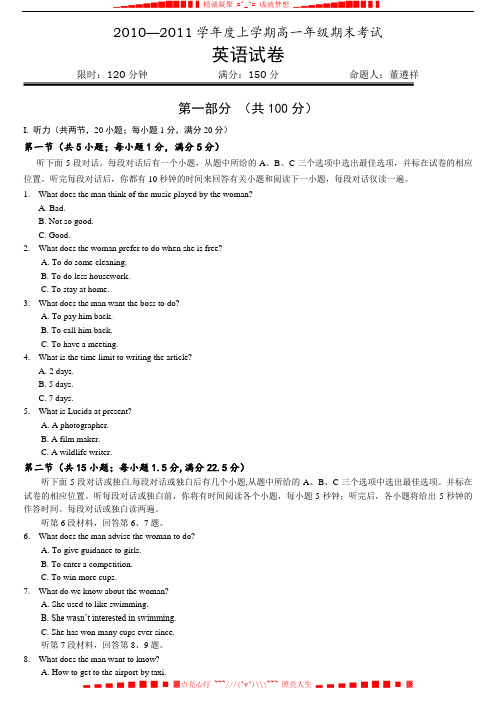
2010—2011学年度上学期高一年级期末考试英语试卷限时:120分钟满分:150分命题人:董遵祥第一部分(共100分)I. 听力(共两节,20小题;每小题1分,满分20分)第一节(共5小题;每小题1分,满分5分)听下面5段对话。
每段对话后有一个小题,从题中所给的A、B、C三个选项中选出最佳选项,并标在试卷的相应位置。
听完每段对话后,你都有10秒钟的时间来回答有关小题和阅读下一小题,每段对话仅读一遍。
1.What does the man think of the music played by the woman?A. Bad.B. Not so good.C. Good.2.What does the woman prefer to do when she is free?A. To do some cleaning.B. To do less housework.C. To stay at home.3.What does the man want the boss to do?A. To pay him back.B. To call him back.C. To have a meeting.4.What is the time limit to writing the article?A. 2 days.B. 5 days.C. 7 days.5.What is Lucida at present?A. A photographer.B. A film maker.C. A wildlife writer.第二节(共15小题;每小题1.5分,满分22.5分)听下面5段对话或独白.每段对话或独白后有几个小题,从题中所给的A、B、C三个选项中选出最佳选项。
并标在试卷的相应位置。
听每段对话或独白前,你将有时间阅读各个小题,每小题5秒钟;听完后,各小题将给出5秒钟的作答时间。
每段对话或独白读两遍。
2010英语-湖北
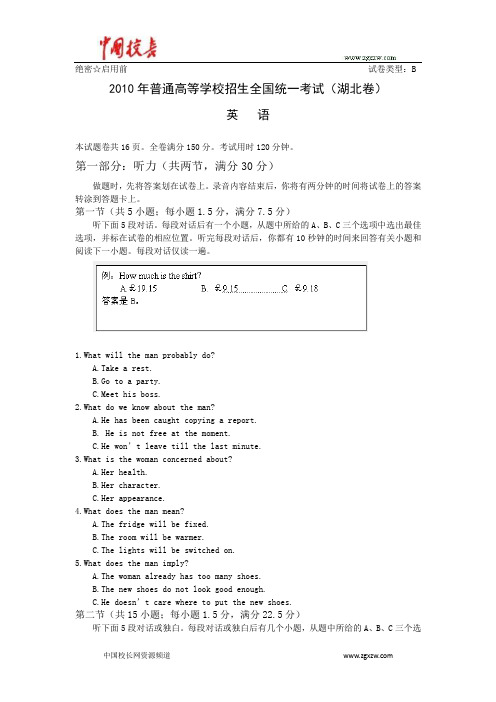
绝密☆启用前试卷类型:B 2010年普通高等学校招生全国统一考试(湖北卷)英语本试题卷共16页。
全卷满分150分。
考试用时120分钟。
第一部分:听力(共两节,满分30分)做题时,先将答案划在试卷上。
录音内容结束后,你将有两分钟的时间将试卷上的答案转涂到答题卡上。
第一节(共5小题;每小题1.5分,满分7.5分)听下面5段对话。
每段对话后有一个小题,从题中所给的A、B、C三个选项中选出最佳选项,并标在试卷的相应位置。
听完每段对话后,你都有10秒钟的时间来回答有关小题和阅读下一小题。
每段对话仅读一遍。
1.What will the man probably do?A.Take a rest.B.Go to a party.C.Meet his boss.2.What do we know about the man?A.He has been caught copying a report.B. He is not free at the moment.C.He won’t leave till the last minute.3.What is the woman concerned about?A.Her health.B.Her character.C.Her appearance.4.What does the man mean?A.The fridge will be fixed.B.The room will be warmer.C.The lights will be switched on.5.What does the man imply?A.The woman already has too many shoes.B.The new shoes do not look good enough.C.He doesn’t care where to put the new shoes.第二节(共15小题;每小题1.5分,满分22.5分)听下面5段对话或独白。
2010年外语考研真题及答案解析

2010年全国硕士研究生入学统一考试英语试题Section I Use of English丁晓钟:2010年考研英语一真题参考答案Directions:Read the following text. Choose the best word(s) for each numbered blank and mark [A], [B], [C] or [D] on ANSWER SHEET 1. (10 points)In 1924 American’ National Research Council sent to engineers to supervise a series of industrial experiments at a large telephone-parts factory called the Hawthorne Plant near Chicago. It hoped they would learn how stop-floorlignting__1__workers productivity. Instead, the studies ended __2___giving their name to the “Hawthorne effect”, the extremely influential idea that thevery___3____to being experimented upon changed subjects’ behavior.The idea arose because of the __4____behavior of the women in the Hawthorne plant. According to __5____of the experiments, their hourly output rose when lighting was increased, but also when it was dimmed. It did not __6____what was done in the experiment; ___7_someting was changed ,productivity rose. A(n)___8___that they were being experimented upon seemed to be ____9___to alter workers’ behavior ____10____itself.After several decades, the same data were _11__ to econometric the analysis. Hawthorne experiments has another surprise store _12 __the descriptions on record, no systematic _13__ was found that levels of productivity were related to changes in lighting. It turns out that peculiar way of conducting the experiments may be have let to__ 14__ interpretation of what happed.__ 15___ , lighting was always changed on a Sunday .When work started again on Monday, output __16___ rose compared with the previous Saturday and__ 17 __to rise for the next couple of days.__ 18__ , a comparison with data for weeks when there was no experimentation showed that output always went up on Monday, workers__ 19__ to be diligent for the first few days of the week in any case , before __20 __a plateau and then slackening off. This suggests that the alleged” Hawthorne effect “ is hard to pin down.1. [A] affected [B] achieved [C] extracted [D] restored2. [A] at [B]up[C] with [D] off3. [A]truth [B]sight [C] act [D] proof4. [A] controversial [B] perplexing [C]mischievous [D] ambiguous5. [A]requirements [B]explanations [C] accounts [D] assessments6. [A] conclude [B] matter[C] indicate [D] work7. [A] as far as [B] for fear that [C] in case that [D] so long as8. [A] awareness[B] expectation [C] sentiment [D] illusion9. [A] suitable[B] excessive [C] enough [D] abundant10. [A] about [B] for[C] on [D] by11. [A] compared [B]shown [C] subjected [D] conveyed12. [A] contrary to [B] consistent with [C] parallel with [D] pealliar to13. [A] evidence [B]guidance [C]implication [D]source14. [A] disputable [B]enlightening [C]reliable [D]misleading15. [A] In contrast [B] For example [C] In consequence [D] As usual16. [A] duly [B]accidentally [C] unpredictably [D] suddenly17. [A]failed [B]ceased [C]started [D]continued18. [A]Therefore [B]Furthermore [C]However [D]Meanwhile19. [A]Attempted [B]tended [C]chose [D]intenced20. [A]breaking [B]climbing [C]surpassing [D]hitingSection II Reading ComprehensionPart ADirections:Read the following four texts. Answer the questions below each text by choosing [A], [B], [C] or [D]. Mark your answers on ANSWER SHEET 1. (40 points)Text 1Of all the changes that have taken place in English-language newspapers during the past quarter-century, perhaps the most far-reaching has been the inexorable decline in the scope and seriousness of their arts coverage. Not only have many newspapers done away with their book-review sections, but several major papers, including the Chicago Sun-Times and the Minneapolis Star-Tribune, no longer employ full-time classical-music critics. Even those papers that continue to reviewfine-arts events are devoting less space to them, while the “think pieces” on cultural subjects that once graced the pages of big-city Sunday papers are becoming a thing of the past.It is, I suspect, difficult to the point of impossibility for the average reader under the age of forty to imagine a time when high-quality arts criticism could be found in most big-city newspapers. Yet a considerable number of the most significant collections of criticism published in the 20th century, including Virgil Thomson’s The Musical Scene (1945), Edwin Denby’s Looking at the Dance (1949), Kenneth Tynan’s Curtains (1961), and Hilton Kramer’s The Age of the Avant-Garde (1973) consisted in large part of newspaper reviews. To read such books today is to marvel at the fact that their erudite contents were once deemed suitable for publication in general-circulation dailies.We are even farther removed from the discursive newspaper reviews published in England between the turn of the 20th century and the eve of World War II, at a time when newsprint was dirt-cheap and stylish arts criticism was considered an ornament to the publications in which it appeared. In those far-off days, it was taken for granted that the critics of major papers would write in detail and at length about the events they covered.1 Theirs was a serious business, and even those reviewers who wore their learning lightly, like George Bernard Shaw and Ernest Newman, could be trusted to know what they were about. These men (for they were all men) believed in journalism as a calling, and were proud to be published in the daily press. “So few authors have brains enough or literary gift enough to keep their own end up in journalism,” Newman wrote, “that I am tempted to define‘journalism’ as ‘a term of contempt applied by writers who are not read to writers who are.’”Why, then, are virtually all of these critics forgotten? Neville Cardus, who wrote for the Manchester Guardian from 1917 until shortly before his death in 1975, is now known solely as a writer of essays on the game of cricket. During his lifetime, though, he was also one of England’s foremost classica l-music critics, a stylist so widely admired that his Autobiography (1947) became a best-seller. He was knighted in 1967, the first music critic to be so honored. Yet only one of his books is now in print, and his vast body of writings on music is unknown save to specialists. How is it possible that so celebrated a critic should have slipped into near-total obscurity?21. It is indicated in Paragraphs 1 and 2 thatA arts criticism has disappeared from big-city newspapers.B English-language newspapers used to carry more arts reviews.C high-quality newspapers retain a large body of readers.D young readers doubt the suitability of criticism on dailies.22. Newspaper reviews in England before World War 2 were characterized byA free themes.B casual style.C elaborate layout.D radical viewpoints.23. Which of the following would shaw and Newman most probably agree on?A It is writers' duty to fulfill journalistic goals.B It is contemptible for writers to be journalists.C Writers are likely to be tempted into journalism.D Not all writers are capable of journalistic writing.24. What can be learned about Cardus according to the last two paragraphs?A His music criticism may not appeal to readers today.B His reputation as a music critic has long been in dispute.C His style caters largely to modern specialists.D His writings fail to follow the amateur tradition.25. What would be the best title for the text?A Newspapers of the Good Old DaysB The Lost Horizon in NewspapersC Mournful Decline of JournalismD Prominent ritics in MemoryC Text 2Over the past decade, thousands of patents have been granted for what are called business methods. received one for its “one-click” online payment system. Merrill Lynch got legal protection for an asset allocation strategy. One inventor patented a technique for lifting a box.Now the nation’s top patent court appears completely ready to scale back on business-method patents, which have been controversial ever since they were first authorized 10 years ago. In a move that has intellectual-property lawyers abuzz the U.S. court of Appeals for the federal circuit said it would use a particular case to conduct a broad review of business-method patents. In re Bilski , as the case is known , is “a very big deal”, says Dennis’D. Crouch of the University of Missouri School of law. It “has the potential to eliminate an entire class of patents.”Curbs on business-method claims would be a dramatic about-face, because it was the federal circuit itself that introduced such patents with is 1998 decision in the so-called state Street Bank case, approving a patent on a way of pooling mutual-fund assets. That ruling produced an explosion in business-method patent filings, initially by emerging internet companies trying to stake out exclusive pinhts to specific types of online transactions. Later, move established companies raced to add such patents to their files, if only as a defensive move against rivalsthat might beat them to the punch. In 2005, IBM noted in a court filing that it had been issued more than 300 business-method patents despite the fact that it questioned the legal basis for granting them. Similarly, some Wall Street investment films armed themselves with patents for financial products, even as they took positions in court cases opposing the practice.The Bilski case involves a claimed patent on a method for hedging risk in the energy market. The Federal circuit issued an unusual order stating that the case would be heard by all 12 of the court’s judges, rather than a typical panel of three, and that one issue it wants to evaluate is whether it should” reconsider” its state street Bank ruling.The Federal Circuit’s action comes in the wake of a series of recent decisions by the supreme Count that has narrowed the scope of protections for patent holders. Last April, for example the justices signaled that too many patents were being upheld for “inventions” that are obvious. The judges on the Federal circuit are “reacting to the anti_ patent trend at the supreme court”,says Harole C.wegner, a partend attorney and professor at aeorge Washington University Law School.26. Business-method patents have recently aroused concern because of[A] their limited value to business[B] their connection with asset allocation[C] the possible restriction on their granting[D] the controversy over authorization27. Which of the following is true of the Bilski case?[A] Its ruling complies with the court decisions[B] It involves a very big business transaction[C] It has been dismissed by the Federal Circuit[D] It may change the legal practices in the U.S.28. The word “about-face” (Line 1, Paro 3) most probably means[A] loss of good will[B] increase of hostility[C] change of attitude[D] enhancement of dignity29. We learn from the last two paragraphs that business-method patents[A] are immune to legal challenges[B] are often unnecessarily issued[C] lower the esteem for patent holders[D] increase the incidence of risks30. Which of the following would be the subject of the text?[A] A looming threat to business-method patents[B] Protection for business-method patent holders[C] A legal case regarding business-method patents[D] A prevailing trend against business-method patentsText 3In his book The Tipping Point, Malcolm Aladuell argues that social epidemics are driven in large part by the acting of a tiny minority of special individuals, often called influentials, who are unusually informed, persuasive, orwell-connected. The idea is intuitively compelling, but it doesn’t expl ain how ideas actually spread.The supposed importance of influentials derives from a plausible sounding but largely untested theory called the “two step flow of communication”: Information flows from the media to the influentials and from them to everyone else. Marketers have embraced the two-step flow because it suggests that if they can just find and influence the influentials, those selected people will do most of the work for them. The theory also seems to explain the sudden and unexpected popularity of certainlooks, brands, or neighborhoods. In many such cases, a cursory search for causes finds that some small group of people was wearing, promoting, or developing whatever it is before anyone else paid attention. Anecdotal evidence of this kind fits nicely with the idea that only certain special people can drive trendsIn their recent work, however, some researchers have come up with the finding that influentials have far less impact on social epidemics than is generally supposed. In fact, they don’t se em to be required of all.The researchers’ argument stems from a simple observing about social influence, with the exception of a few celebrities like Oprah Winfrey-whose outsize presence is primarily a function of media, not interpersonal, influence-even the most influential members of a population simply don’t interact with that many others. Yet it is precisely these non-celebrity influentials who, according to thetwo-step-flow theory, are supposed to drive social epidemics by influencing their friends and colleagues directly. For a social epidemic to occur, however, each person so affected, must then influence his or her own acquaintances, who must in turn influence theirs, and so on; and just how many others pay attention to each of these people has little to do with the initial influential. If people in the network just two degrees removed from the initial influential prove resistant, for example from the initial influential prove resistant, for example the cascade of change won’t propagate very far or affect many people.Building on the basic truth about interpersonal influence, the researchers studied the dynamics of populations manipulating a number of variables relating of populations, manipulating a number of variables relating to people’s ability t o influence others and their tendency to be influenced. Our work shows that the principal requirement for what we call “global cascades”- the widespread propagation of influence through networks - is the presence not of a few influentials but, rather, of a critical mass of easily influenced people, each of whom adopts, say, a look or a brand after being exposed to a single adopting neighbor. Regardless of how influential an individual is locally, he or she can exert global influence only if this critical mass is available to propagate a chain reaction.31.By citing the book The Tipping Point, the author intends to[A]analyze the consequences of social epidemics[B]discuss influentials’ function in spreading ideas[C]exemplify people’s intuitive response to s ocial epidemics[D]describe the essential characteristics of influentials.32.The author suggests that the “two-step-flow theory”[A]serves as a solution to marketing problems[B]has helped explain certain prevalent trends[C]has won support from influentials[D]requires solid evidence for its validity33.what the researchers have observed recently shows that[A] the power of influence goes with social interactions[B] interpersonal links can be enhanced through the media[C] influentials have more channels to reach the public[D] most celebrities enjoy wide media attention34.The underlined phrase “these people” in paragraph 4 refers to the ones who[A] stay outside the network of social influence[B] have little contact with the source of influence[C] are influenced and then influence others[D] are influenced by the initial influential35.what is the essential element in the dynamics of social influence?[A]The eagerness to be accepted[B]The impulse to influence others[C]The readiness to be influenced[D]The inclination to rely on othersText 4Bankers have been blaming themselves for their troubles in public. Behind the scenes, they have been taking aim at someone else: the accounting standard-setters. Their rules, moan the banks, have forced them to r eport enormous losses, and it’s just not fair. These rules say they must value some assets at the price a third party would pay, not the price managers and regulators would like them to fetch.Unfortunately, banks’ lobbying now seems to be working. The det ails may be unknowable, but the independence of standard-setters, essential to the proper functioning of capital markets, is being compromised. And, unless banks carry toxic assets at prices that attract buyers, reviving the banking system will be difficult.After a bruising encounter with Congress, America’s Financial Accounting Standards Board (FASB) rushed through rule changes. These gave banks more freedom to use models to value illiquid assets and more flexibility in recognizing losses on long-term ass ets in their income statement. Bob Herz, the FASB’s chairman, cried out against those who “question our motives.” Yet bank shares rose and the changes enhance what one lobby group politely calls “the use of judgment by management.”European ministers instantly demanded that the International Accounting Standards Board (IASB) do likewise. The IASB says it does not want to act without overall planning, but the pressure to fold when it completes it reconstruction of rules later this year is strong. Charlie McCreevy, a European commissioner, warned the IASB that it did “not live in a political vacuum” but “in the real word” and that Europe could yet develop different rules.It was banks that were on the wrong planet, with accounts that vastly overvalued assets. Today they argue that market prices overstate losses, because they largely reflect the temporary illiquidity of markets, not the likely extent of bad debts. The truth will not be known for years. But bank’s shares trade below their book value, suggesting that investors are skeptical. And dead markets partly reflect the paralysis of banks which will not sell assets for fear of booking losses, yet are reluctant to buy all those supposed bargains.To get the system working again, losses must be recognized and dealt with. America’s new plan to buy up toxic assets will not work unless banks mark assets to levels which buyers find attractive. Successful markets require independent andeven combative standard-setters. The FASB and IASB have been exactly that, cleaning up rules on stock options and pensions, for example, against hostility form special interests. But by giving in to critics now they are inviting pressure to make more concessions.36. Bankers complained that they were forced to[A] follow unfavorable asset evaluation rules[B]collect payments from third parties[C]cooperate with the price managers[D]reevaluate some of their assets.37.According to the author , the rule changes of the FASB may result in[A]the diminishing role of management[B]the revival of the banking system[C]the banks’ long-term asset losses[D]the weakening of its independence38.According to Paragraph 4, McCreevy objects to the IASB’s attempt to[A]keep away from political influences.[B]evade the pressure from their peers.[C]act on their own in rule-setting.[D]take gradual measures in reform.39.The author thinks the banks were “on the wrong planet ”in that they[A]misinterpreted market price indicators[B]exaggerated the real value of their assets[C]neglected the likely existence of bad debts.[D]denied booking losses in their sale of assets.40.The author’s attitude towards standard-setters is one of[A]satisfaction.[B]skepticism.[C]objectiveness[D]sympathyPart BDirections:For Questions 41-45, choose the most suitable paragraphs from the list A-G and fill them into the numbered boxes to form a coherent text. Paragraph E has been correctly placed. There is one paragraph which dose not fit in with the text. Mark your answers on ANSWER SHEET1. (10 points)[A] The first and more important is the consumer’s growing preference for eating out; the consumption of food and drink in places other than homes has risen from about 32 percent of total consumption in 1995 to 35 percent in 2000 and is expected to approach 38 percent by 2005. This development is boosting wholesale demand from the food service segment by 4 to 5 percent a year across Europe, compared with growth in retail demand of 1 to 2 percent. Meanwhile, as the recession is looming large, people are getting anxious. They tend to keep a tighter hold on their purse and consider eating at home a realistic alternative.[B] Retail sales of food and drink in Europe’s largest markets are at a standstill, leaving European grocery retailers hungry for opportunities to grow. Most leading retailers have already tried e-commerce, with limited success, and expansion abroad. But almost all have ignored the big, profitable opportunity in their own backyard: the wholesale food and drink trade, which appears to be just the kind of market retailers need.[C] Will such variations bring about a change in the overall structure of the food and drink market? Definitely not. The functioning of the market is based on flexible trends dominated by potential buyers. In other words, it is up to the buyer, rather than the seller, to decide what to buy .At any rate, this change willultimately be acclaimed by an ever-growing number of both domestic and international consumers, regardless of how long the current consumer pattern will take hold.[D] All in all, this clearly seems to be a market in which big retailers could profitably apply their scale, existing infrastructure and proven skills in the management of product ranges, logistics, and marketing intelligence. Retailers that master the intricacies of wholesaling in Europe may well expect to rake in substantial profits thereby. At least, that is how it looks as a whole. Closer inspection reveals important differences among the biggest national markets, especially in their customer segments and wholesale structures, as well as the competitive dynamics of individual food and drink categories. Big retailers must understand these differences before they can identify the segments of European wholesaling in which their particular abilities might unseat smaller but entrenched competitors. New skills and unfamiliar business models are needed too.[E] Despite variations in detail, wholesale markets in the countries that have been closely examined-France, Germany, Italy, and Spain-are made out of the same building blocks. Demand comes mainly from two sources: independent mom-and-pop grocery stores which, unlike large retail chains, are two small to buy straight from producers, and food service operators that cater to consumers when they don’t eat at home. Such food service operators range from snack machines to large institutional catering ventures, but most of these businesses are known in the trade as “horeca”: hotels, restaurants, and cafes. Overall, Europe’s wholesale market for food and drink is growing at the same sluggish pace as the retail market, but the figures, when added together, mask two opposing trends.[F] For example, wholesale food and drink sales come to $268 billion in France, Germany, Italy, Spain, and the United Kingdom in 2000-more than 40 percent of retail sales. Moreover, average overall margins are higher in wholesale than in retail; wholesale demand from the food service sector is growing quickly as more Europeans eat out more often; and changes in the competitive dynamics of this fragmented industry are at last making it feasible for wholesalers to consolidate.[G] However, none of these requirements should deter large retailers (and even some large good producers and existing wholesalers) from trying their hand, for those that master the intricacies of wholesaling in Europe stand to reap considerable gains.Part CDirections:Read the following text carefully and then translate the underlined segments into Chinese. Your translation should be written carefully on ANSWER SHEET 2. (10 points)One basic weakness in a conservation system based wholly on economic motives is that most members of the land community have no economic value. Yet these creatures are members of the biotic community and, if its stability depends on its integrity, they are entitled to continuance.When one of these noneconomic categories is threatened and, if we happen to love it .We invert excuses to give it economic importance. At the beginning of century songbirds were supposed to be disappearing.(46) Scientists jumped to the rescue with some distinctly shaky evidence to the effect that insects would eat us up if birds failed to control them, the evidence had to be economic in order to be valid.It is painful to read these round about accounts today. We have no land ethic yet,(47) but we have at least drawn near the point of admitting that birds should continue as a matter of intrinsic right, regardless of the presence or absence of economic advantage to us.A parallel situation exists in respect of predatory mammals and fish-eating birds .(48) Time was when biologists somewhat over worded the evidence that these creatures preserve the health of game by killing the physically weak, or that they prey only on “worthless” species.Some species of tree have been read out of the party by economics-minded foresters because they grow too slowly, or have too low a sale vale to pay as imeber crops (49) In Europe, where forestry is ecologically more advanced, thenon-commercial tree species are recognized as members of native forest community, to be preserved as such, within reason.To sum up: a system of conservation based solely on economic self-interest is hopelessly lopsided. (50) It tends to ignore, and thus eventually to eliminate, many elements in the land community that lack commercial value, but that are essential to its healthy functioning. Without the uneconomic pats.Section Ⅲ WritingPart A51. Directions:You are supposed to write for the postgraduate association a notice to recruit volunteers for an international conference on globalization, you should conclude the basic qualification of applicant and the other information you think relative.You should write about 100 words. Do not sign your own name at the end of the letter. Use “postgraduate association” instead.Part B52. Directions:Write an essay of 160-200 words based on the following drawing. In your essay, you should1) describe the drawing briefly,2) explain its intended meaning, and then3) give your comments.You should write neatly on ANSHWER SHEET 2. (20 points)Section I Use of English1.A解析:A项 affect 意思是"影响,感动"; B项 achieve意思是"达成,完成"; C项extract意思是"提取,榨出";D项restore是"恢复,重建". 这句话的意思是:他们想通过实验探究车间照明是如何影响工人的生产率的,所以答案是A。
武汉市2010年4月调考英语及答案
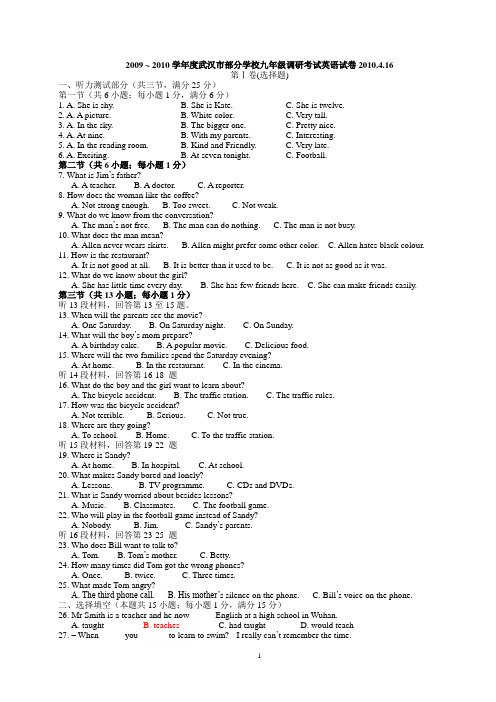
2009 ~ 2010学年度武汉市部分学校九年级调研考试英语试卷2010.4.16第Ⅰ卷(选择题)一、听力测试部分(共三节,满分25分)第一节(共6小题;每小题1分,满分6分)1. A. She is shy. B. She is Kate. C. She is twelve.2. A. A picture. B. White color. C. Very tall.3. A. In the sky. B. The bigger one. C. Pretty nice.4. A. At nine. B. With my parents. C. Interesting.5. A. In the reading room. B. Kind and Friendly. C. Very late.6. A. Exciting. B. At seven tonight. C. Football.第二节(共6小题;每小题1分)7. What is Jim’s father?A. A teacher.B. A doctor.C. A reporter.8. How does the woman like the coffee?A. Not strong enough.B. Too sweet.C. Not weak.9. What do we know from the conversation?A. The man’s not free.B. The man can do nothing.C. The man is not busy.10. What does the man mean?A. Allen never wears skirts.B. Allen might prefer some other color.C. Allen hates black colour.11. How is the restaurant?A. It is not good at all.B. It is better than it used to be.C. It is not as good as it was.12. What do we know about the girl?A. She has little time every day.B. She has few friends here.C. She can make friends easily. 第三节(共13小题;每小题1分)听13段材料,回答第13至15题。
- 1、下载文档前请自行甄别文档内容的完整性,平台不提供额外的编辑、内容补充、找答案等附加服务。
- 2、"仅部分预览"的文档,不可在线预览部分如存在完整性等问题,可反馈申请退款(可完整预览的文档不适用该条件!)。
- 3、如文档侵犯您的权益,请联系客服反馈,我们会尽快为您处理(人工客服工作时间:9:00-18:30)。
e度的家长们,孩子们,感谢你们对外校系列帖的关注与支持,学而思英语外校研究团队真诚为你奉上2010年外校英语真题详析。
预祝大家备考顺利!2010命题特点:特点1:2010年英语试题较2008,2009年难度呈上升趋势。
变化体现在听力、笔试和思维发展三部分分值的调整。
特点2:在笔试部分,摒弃了传统的基础知识考查方式(如完形填空),侧重考察考生的综合阅读理解能力。
特点3:思维发展部分考察面不断扩宽。
2010外校英语试题考点解析1. 听力部分从分值看,听力由去年的30分上涨至35分,题量由六大题升至七大题,题型基本保持稳定,但在细节上做了微调。
表现在:一. 听力第一小题由听歌选择变为听歌填空,要求学生听一首英语儿歌并填词,这题不光考学生的耳朵,也考查联系上下文进行推断的能力。
二. 六七大题依然是听力部分的难点题,也是拉分题。
主要以图句配对,判断选择为主,但在听力材料的内容理解上难度增加,2010年本题是关于美国地域文化和墨西哥概况。
考生对材料相对陌生,所以得分相当不理想。
该材料来源于九年级课外阅读。
2. 阅读部分2010的阅读部分让人始料未及,分值从25分直降至10分,题型也由传统的阅读理解题转变的更加灵活,选材也更贴近日常生活。
试卷上的第一个阅读是句子排序,题目给出了首尾的两句,降低了难度。
这种题要求考生能读懂每个句子,捕捉句中有效信息并能串联信息。
第二个阅读根据描述选择对应的网站,较容易得分,每句都很长并有很多超纲词汇,但并不影响考生理解大致意思,此题考查学生从大量信息中筛选有效信息的能力,排除干扰项快速判断等能力。
另一个必须强调的是,虽然2010的阅读只有10分,但这绝不表明外校考试对阅读能力的要求降低。
恰恰相反,要求更高,从后面的思维扩展题看出,考生必须要能读懂句子才能理解题意,否则就算你数学再好,也只能是巧妇难为无米之炊。
3. 思维发展部分2010年的思维发展题占20分,题量加大,题型多样化的特点越来越明显,包括数字图形推断题,知识面,行为规范等方面。
这部分的题是让家长和考生最头疼的,因为太灵活,不好针对性复习。
但从试题中我们可以分析出外校对学生综合能力的要求异常高,要求学生至少具备中考英语词汇量、阅读理解水平,逻辑推理判断能力和知识迁移能力。
听力第一题(答案及解析)I’m a policeman dressed in blue, here are some thing s I like to do. Direct the traffic in your town, help to keep you safe and sound.It’s my job and I like it fine. No one has a better job than mine.I’m a policeman dressed in blue, I want to be a friend to you.you can see me every day,I will wave my hand to see.it my job and I like it fine. No one has a better job than mine.解析:本题考点有词语拼写正确,名词的单复数和将来时态;解题技巧:在预习时对填词处进行初步判断,切忌边听边填。
通过语法判断答案也是得分的有效途径。
如things,如果只听到thing,就要通过Here are some判断出thing应该是复数。
通过冠词a,判断出其后名词为单数。
通过will判断其后动词为原形。
本题是英语儿歌,歌曲流畅,歌手吐词清晰,所有填词范围在新概念英语第一册之内。
每空一分,共五分,本题要求达到九年级学生听力水平。
阅读第一题(答案):解析:要求学生将打乱的句子重新排列成符合逻辑的语篇。
本题考点在于学生对于句子的理解,词汇量的把握。
特别是划分句子成分,理解句子的层次。
本题还考察了对动词grow的用法,grow做系动词用法,grow into/grow on 词组等。
能力拓展真题选及解析解析:这是思维发展题,但更是阅读题。
52题考到形容词最高级和数字的表达,不过只要考生能理解large number的意思就能做题,数字表达涉及百分数,小数,分数等表达,已达到九年级要求。
53题题干中environment(环境)是核心词,再看ABC 三个选项中刷黄的部分,是判断习惯good or not的关键。
一. 总分及分值分布预测图表一表一分析:表一呈现近5年外校英语试题的总分变化,06-08年处于调整期,总分波动大,09-10年趋于稳定,总分均为65分。
图表二表二分析:近5年外校英语试题听力部分分值成逐年上升趋势,2010年听力分值35分,占总分的一半以上。
阅读部分分值在近3年分值直线下降,思维发展部分分值在经历了06-08年的锐减之后在近2年呈上升趋势。
预测1:2011年外校试题英语部分总分与10年持平,听力阅读思维发展三部分分值分布有可能调整。
预测2:2011年外校试题英语部分听力分值与10年持平,也有可能回调至30分,阅读部分分值上升,思维发展部分略降。
二. 听力阅读思维发展三大部分题型预测1.听力部分图表三表三分析1:从第一横排看出,外校考试英语听力第一题从06年到10年,考查侧重由语音基础向听力技能的转变。
表三分析2:从06至10年的听力二三四题的设置,可以捕捉到外校听力的常规题:听问题选答句,听对话选答句和图句搭配。
表三分析3:针对历年的听力拉分题可以看出,考查题型每年都有微变,但大体上以选择,填空,判断连线为主。
预测1:2011年外校考试英语听力,题型与08,09年保持一致,听力拉分题趋近中考听力材料题。
预测2:2011年外校考试英语听力常规题型还会出现。
2.阅读部分图表四表四分析1:从06至10年外校英语试题的阅读部分,我们可以看出只有10年没有考阅读理解题。
表四分析2:阅读选择题是近3年的常考题型,也是新题型。
预测:2011年外校英语阅读部分,篇章阅读理解题很有可能再次出现,阅读选择或填空出现几率大。
3.思维发展部分从近5年的外校思维发展试题分析,每年这部分题目题型变化大,考点范围广,但仍可总结出两个趋势:1. 越来越重视对数学,英语等其他学科的交叉运用能力的考查。
2. 对学生综合素质的检验,智能与品格并重。
三. 4月专项复习小建议:1. 下载难度适当的英文歌曲,进行听歌写句子的练习,听一句写一句。
2. 做初中七八年级的听力练习题,特别是听问句选答句,听对话选答句这两种题型。
3. 做初中七八年级的阅读理解题,内容以环境,人文,科学等题材为主。
4. 尽可能增加听力词汇和阅读词汇。
历年外校听力试题专项分析e度的家长们,孩子们,针对在外校考试中考生最薄弱的听力环节,学而思英语外校研究团队倾力奉上历年外校听力试题专项分析。
1. 听力成绩决定外校考试英语成绩图表一表一中,外校英语试题听力分值所占比重逐年增加,在2010年的外校考试中,听力分值高达35分,占总比分的54%。
所以听力成绩在一定程度上决定外校英语成绩。
2. 08至10年外校经典听力题精析歌曲电影片段题图表二图表三精析1:外校听力歌曲电影题多以客观选择题为主,听力材料难度大,10年新增填词题,听力选材比08、09简单。
精析2:从题目设置来看,都是事实细节题。
都是在听力材料中反复出现的,不需做任何推断就可选出的题。
例如09年的第1-2题,问“Hakuna Matata”是什么意思,是一个什么样的词组,这题答案是歌曲中反复出现的句子It means no worries. What a wonderful phrase.多次出现降低听力难度,但此题对学生的词汇要求高。
再比如08年的第1-2题,问“这首歌是写给谁的,下列哪个句子你从歌中听了”,这首Hand in hand是非常经典的歌,对于听过的考生几乎是送分题,对于没听过的只要能读懂题也不难。
常规题型精析外校考试的听力常规题型是听问句选答句,听对话选答句,听对话选图片,在06-10年外校英语听力题的第二至四答题都出现过(见预测帖的表三),呈现的考点有一定共性:1. 听问句选答句通常有1-2题是关于交际用语的,还会设置一个长难句的问题。
比如,08年第二大题考查了学生对特殊疑问词How long/How often/how的区分用法。
2. 听对话选图片这一大题所用听力材料难度适中,想拿分关键是能读懂问题。
比如,08年的第三题设问就出现情态动词must,现在完成时,超纲词组according to,七年级下册句型What does he want to be?,由此可见,扎实的语法功底在外校考试中是至关重要的。
3. 听对话选答句这一大题趋近于中考听力题型,并且通常有一至两题推断题。
比如,09年的第四大题第2小题,听一小段对话问Where does this dialogue take place?这段对话发生在哪,这种题要求学生根据对话细节进行简单推断。
这个题是必考题,近三年每年都出现过。
拉分题精析08至10年外校考试的英语听力拉分题都是听力材料题,材料长度有120-150个单词,题型多样(单选,判断,连线等),语速快并且只能听两遍。
1.从听力材料的选择来看,范围很广。
08年是关于动物,09年关于家庭生活和关于fox的文化,10年是关于美国的地域文化和墨西哥。
2.从题目设置上看,也是以事实细节题为主。
08和09年的听力最后两大题,题型难度偏大(有判断、连线和填空),但听力材料内容相对简单。
而10年则相反,题目难度降低,但听力材料内容学生很陌生。
外校英语听力备考建议:1. 养成正确做听力题的习惯:先快速阅读题干,带着问题去听。
2. 平时训练严格遵守“只听一遍”的原则。
3. 尝试做听力笔记。
4. 合理布局:常规题,歌曲电影题不丢分,拉分题听细节巧得分。
4. 巩固语法知识和扩展词汇量。
(这条不是一朝一夕能做成,要长期积累。
)。
